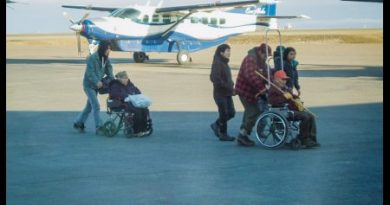City of Whitehorse considers adding $2.2M to budget to cover landslide costs

City applying for federal funding to pay for long-term solution at clay cliffs
The most recent road-closing spring landslide — and the threat of yet another next year — could cost the city of Whitehorse $2.2 million.
This April, Robert Service Way closed for the second year in a row after a landslide from the adjacent clay cliffs obstructed traffic. The road has since reopened, but the work it took to clear debris and monitor the cliffs for safety has been costly.
As will preparations for next year’s spring melt, when the risk of landslides is highest.
City staff are recommending that council amend this year’s budget, drawing $2.2 million from the city’s general reserve fund.
That would cover the cost of this year’s landslide — assuming there aren’t any more in the area — and the purchase of equipment to prepare for potential slides next year. Some money would also pay for personnel to monitor the cliffs for instability each spring.
Though the cliffs have always had some movement, it’s only in recent years that landslides have become a major concern.
More snowfall in Whitehorse has led to a higher risk of landslides during the annual spring melt, or “freshet” season, city staff told council at Monday’s standing committee meeting. That’s because heavier snowpacks saturate the ground on the sandy, silty Whitehorse escarpment, making it more prone to slides as the weather warms, the Yukon Geological Survey told CBC in March.
New reality for Whitehorse escarpment
The city’s director of operations, Tracy Allen, says that’s likely to become a pattern.
“There’s a high probability that there will be continued [landslides] along the escarpment during the freshet period of April to June in subsequent years until a long-term solution can be implemented,” she told council Monday night.
With part of Robert Service Way right at the bottom of the cliffs, Allen said the city needs to prepare to prevent future road closures whenever possible.
“Given the significant adverse impacts of closing the major arterial roadway to residents, administration is recommending the purchase of some key equipment … that will assist in mitigating the risks and overall number of road closures moving forward.”
Equipment would include a slope scanner, barriers, portable traffic lights and message boards.
Last year’s landslide cost the city approximately $2.3 million, staff said. The Yukon government ultimately covered $2 million of that cost. And the territory is providing $50,000 this year to pay for the design of the still-undetermined long-term solution Allen mentioned.
Mayor Laura Cabott says a rough plan for a long-term fix will be in place soon, so the city can apply to the federal disaster mitigation and adaptation fund before next month’s deadline. She says such a project will likely cost millions of dollars, but will save the city money long-term and prevent annual road closures below the escarpment.
“I think we can expect that — each and every year before there’s a permanent solution — we’re looking at a significant bill.”
Council didn’t vote on whether to approve the additional $2.2 million budget amendment. The recommendation from city staff will come back to council next week.
Related stories from around the North:
Canada: Spring melt in Whitehorse could bring more landslides, geologist says, CBC News



